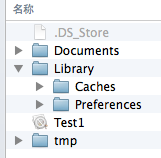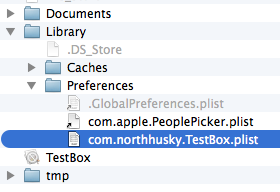
Documents:保存应用运行时生成的需要持久化的数据。例如,游戏应用可将游戏存档保存在该目录。iTunes同步设备时会备份该目录
Library/Preference:保存应用的所有偏好设置,iOS的Settings(设置)应用会在该目录中查找应用的设置信息。iTunes同步设备时会备份该目录
Library/Caches:保存应用运行时生成的需要持久化的数据,一般存储体积大、不需要备份的非重要数据,iTunes同步设备时不会备份该目录。
tmp:保存应用运行时所需的临时数据,使用完毕后再将相应的文件从该目录删除。应用没有运行时,系统也可能会清除该目录下的文件。iTunes同步设备时不会备份该目录
4.获取目录路径代码:
//获取沙盒路径 NSString *home = NSHomeDirectory(); //1.获取Document路径 //1.1通过文件名获取,因为ios以后的新版本可能修改目录名,不建议使用 NSString *documentPath1 = [home stringByAppendingPathComponent:@"Documents"]; //1.2通过系统方法获取,建议使用 NSArray *array = NSSearchPathForDirectoriesInDomains(NSDocumentDirectory, NSUserDomainMask, YES); NSString *documentPath2 = [array objectAtIndex:0]; //2.获取Library/Cache目录,获取方式同Document,下面是系统方法 NSArray *cache = NSSearchPathForDirectoriesInDomains(NSCachesDirectory, NSUserDomainMask, YES); NSString *cachePath = [cache objectAtIndex:0]; //3.获取Library/Preferences也可食用1.1的方式获取,但因为是保存setting设置,一般通过NSUserDefaults直接存储 NSUserDefaults *defaults = [NSUserDefaults standardUserDefaults]; [defaults setObject:@"myname" forKey:@"username"]; //4.获取tmp目录 NSString *tmpPath = NSTemporaryDirectory();
如何在沙盒中操作文件夹和文件,系统提供了
二.文件存储
1.XML属性列表(plist归档)
dataWithContentsOfFile方法读取plist文件中的信息并实例化对象
NSString *tmpPath = NSTemporaryDirectory(); NSString *path = [tmpPath stringByAppendingPathComponent:@"test.plist"]; // 将数据封装成字典 NSMutableDictionary *dict = [NSMutableDictionary dictionary]; [dict setObject:@"jason" forKey:@"name"]; [dict writeToFile:path atomically:YES]; // 读取plist的内容,实例化NSDictionary NSDictionary *dictPlist = [NSDictionary dictionaryWithContentsOfFile:path]; NSLog(@"name:%@", [dictPlist objectForKey:@"name"]);
2.NSUserDefaults(偏好设置)
使用set方法保存不同类型的对象,使用xxxForKey方法获取值
//偏好设置 NSUserDefaults *dft = [NSUserDefaults standardUserDefaults]; [dft setObject:@"jason" forKey:@"username"]; [dft setFloat:1.77f forKey:@"high"]; [dft setBool:YES forKey:@"auto_logon"]; //读取偏好设置 NSUserDefaults *dft2 = [NSUserDefaults standardUserDefaults]; NSString *name = [dft2 objectForKey:@"username"]; float h = [dft2 floatForKey:@"high"]; BOOL al = [dft2 boolForKey:@"auto_logon"]; NSLog(@"%@--%f--%hhd",name,h,al);
自动在Library/Preferences/生成项目名开头的plist文件

3.NSKeyedArchiver 归档(加密形式)
机制类似于java的对象序列化,归档是指将对象保存到文件,反归档(读档)是指将文件内容解析成对象
3.1 NSString、NSDictionary、NSArray、NSData、NSNumber等类型,可以直接用NSKeyedArchiver进行归档和反归档
3.2 任何遵守了NSCoding协议的对象,都可以进行归档和反归档
3.3 NSCoding协议需要实现两个方法:
- (void)encodeWithCoder:(NSCoder *)encoder //将对象归档的时候会调用(将对象写入文件之前会调用),用来说明哪些属性需要归档,怎样归档
-(id)initWithCoder:(NSCoder *)decoder //当从文件中反归档对象时调用,用来说明哪些属性需要反归档,怎样反归档
注:如果父类中也有属性需要归档或者反归档,必须调用super的encodeWithCoder:和initWithCoder:方法
3.4代码实例:
3.4.1 对象类:Person和子类Man
// Person.h #import <Foundation/Foundation.h> @interface Person : NSObject<NSCoding> @property (nonatomic, copy) NSString *name; @property (nonatomic, assign) int age; @property (nonatomic, assign) double height; @end // Person.m #import "Person.h" @implementation Person //归档时调用 - (void)encodeWithCoder:(NSCoder *)coder { [coder encodeObject:_name forKey:@"name"]; [coder encodeInt:_age forKey:@"age"]; [coder encodeDouble:_height forKey:@"height"]; } //反归档时调用调用的初始化方法 -(id)initWithCoder:(NSCoder *)deCode { if (self = [super init]) { _name = [deCode decodeObjectForKey:@"name"]; _age = [deCode decodeIntForKey:@"age"]; _height = [deCode decodeDoubleForKey:@"height"]; } return self; } @end // Man.h继承自Person #import "Person.h" @interface Man : Person @property (nonatomic, copy) NSString *sex; @end // Man.m #import "Man.h" @implementation Man //归档时调用 -(void)encodeWithCoder:(NSCoder *)coder { //首先调用父类的归档方法 [super encodeWithCoder:coder]; [coder encodeObject:_sex forKey:@"sex"]; } //反归档时调用的初始化方法 -(id)initWithCoder:(NSCoder *)deCode { if (self = [super initWithCoder:deCode]) { _sex = [deCode decodeObjectForKey:@"sex"]; } return self; } @end
3.4.1 归档和反归档的实现方法
NSString *tmpPath = NSTemporaryDirectory(); NSString *path1 = [tmpPath stringByAppendingPathComponent:@"person.data"]; NSString *path2 = [tmpPath stringByAppendingPathComponent:@"man.data"]; Person *p = [[Person alloc]init]; p.name = @"a"; p.age = 11; p.height = 1.70f; Man *m = [[Man alloc]init]; m.name = @"b"; m.age = 12; m.height = 1.77f; m.sex = @"male"; //归档 [NSKeyedArchiver archiveRootObject:p toFile:path1]; [NSKeyedArchiver archiveRootObject:m toFile:path2]; //反归档 Person *p2 = [NSKeyedUnarchiver unarchiveObjectWithFile:path1]; Man *m2 = [NSKeyedUnarchiver unarchiveObjectWithFile:path2]; NSLog(@"%@--%d--%f",p2.name,p2.age,p2.height); NSLog(@"%@--%d--%f---%@",m2.name,m2.age,m2.height,m2.sex);
4.SQLite3 & Core Data
都是对数据做操作,CoreData只是在SQLite3的基础上做了一层面向对象的封装,类似于Hibernate,暂不总结,后续会新写文章总结
三.NSFileManager
参考文章:http://www.cnblogs.com/xyzlmn/p/3196930.html
创建文件夹:
//创建文件夹
-(void *)createDir{
NSString *documentsPath =[self dirDoc];
NSFileManager *fileManager = [NSFileManager defaultManager];
NSString *testDirectory = [documentsPath stringByAppendingPathComponent:@"test"];
// 创建目录
BOOL res=[fileManager createDirectoryAtPath:testDirectory withIntermediateDirectories:YES attributes:nil error:nil];
if (res) {
NSLog(@"文件夹创建成功");
}else
NSLog(@"文件夹创建失败");
}
创建文件
//创建文件
-(void *)createFile{
NSString *documentsPath =[self dirDoc];
NSString *testDirectory = [documentsPath stringByAppendingPathComponent:@"test"];
NSFileManager *fileManager = [NSFileManager defaultManager];
NSString *testPath = [testDirectory stringByAppendingPathComponent:@"test.txt"];
BOOL res=[fileManager createFileAtPath:testPath contents:nil attributes:nil];
if (res) {
NSLog(@"文件创建成功: %@" ,testPath);
}else
NSLog(@"文件创建失败");
}
写数据到文件:
//写文件
-(void)writeFile{
NSString *documentsPath =[self dirDoc];
NSString *testDirectory = [documentsPath stringByAppendingPathComponent:@"test"];
NSString *testPath = [testDirectory stringByAppendingPathComponent:@"test.txt"];
NSString *content=@"测试写入内容!";
BOOL res=[content writeToFile:testPath atomically:YES encoding:NSUTF8StringEncoding error:nil];
if (res) {
NSLog(@"文件写入成功");
}else
NSLog(@"文件写入失败");
}
读文件数据:
//读文件
-(void)readFile{
NSString *documentsPath =[self dirDoc];
NSString *testDirectory = [documentsPath stringByAppendingPathComponent:@"test"];
NSString *testPath = [testDirectory stringByAppendingPathComponent:@"test.txt"];
// NSData *data = [NSData dataWithContentsOfFile:testPath];
// NSLog(@"文件读取成功: %@",[[NSString alloc] initWithData:data encoding:NSUTF8StringEncoding]);
NSString *content=[NSString stringWithContentsOfFile:testPath encoding:NSUTF8StringEncoding error:nil];
NSLog(@"文件读取成功: %@",content);
}
文件属性:
//文件属性
-(void)fileAttriutes{
NSString *documentsPath =[self dirDoc];
NSString *testDirectory = [documentsPath stringByAppendingPathComponent:@"test"];
NSFileManager *fileManager = [NSFileManager defaultManager];
NSString *testPath = [testDirectory stringByAppendingPathComponent:@"test.txt"];
NSDictionary *fileAttributes = [fileManager attributesOfItemAtPath:testPath error:nil];
NSArray *keys;
id key, value;
keys = [fileAttributes allKeys];
int count = [keys count];
for (int i = 0; i < count; i++)
{
key = [keys objectAtIndex: i];
value = [fileAttributes objectForKey: key];
NSLog (@"Key: %@ for value: %@", key, value);
}
}
删除文件:
//删除文件
-(void)deleteFile{
NSString *documentsPath =[self dirDoc];
NSString *testDirectory = [documentsPath stringByAppendingPathComponent:@"test"];
NSFileManager *fileManager = [NSFileManager defaultManager];
NSString *testPath = [testDirectory stringByAppendingPathComponent:@"test.txt"];
BOOL res=[fileManager removeItemAtPath:testPath error:nil];
if (res) {
NSLog(@"文件删除成功");
}else
NSLog(@"文件删除失败");
NSLog(@"文件是否存在: %@",[fileManager isExecutableFileAtPath:testPath]?@"YES":@"NO");
}
遍历子文件夹:
NSString *home = NSHomeDirectory();
NSFileManager *fileManage = [NSFileManagerdefaultManager];
NSArray *file = [fileManage subpathsOfDirectoryAtPath: home error:nil];
NSLog(@"%@",file);
NSArray *files = [fileManage subpathsAtPath: home ];
NSLog(@"%@",files);